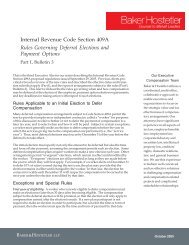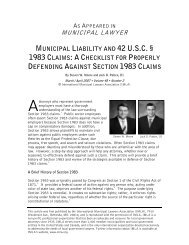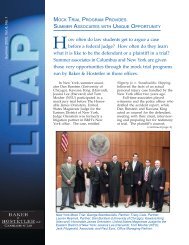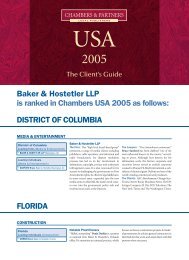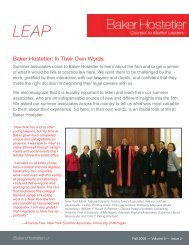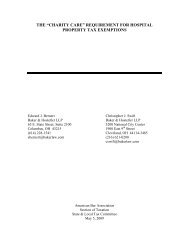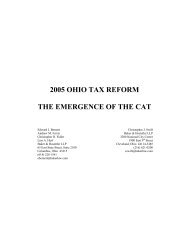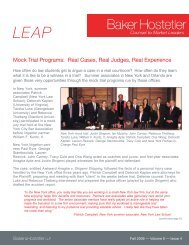Prejudgment Remedies in Texas - Doug D'Arche - Back to Main Page
Prejudgment Remedies in Texas - Doug D'Arche - Back to Main Page
Prejudgment Remedies in Texas - Doug D'Arche - Back to Main Page
- No tags were found...
Create successful ePaper yourself
Turn your PDF publications into a flip-book with our unique Google optimized e-Paper software.
Platter Grocery Co. v. <strong>Texas</strong> & Pac. R.R. Co., 68 S.W. 265, 266 (1902); Alexander v. Berkman,3 S.W.2d 864, 867 (Tex. Civ. App.—Waco 1927, writ ref’d). A liquidated debt is one where theamount owed can be ascerta<strong>in</strong>ed at the time the garnishee's answer is filed. Waples-PlatterGrocery Co. v. <strong>Texas</strong> & Pac. Ry. Co., 95 Tex. 486, 68 S.W. 265, 266 (1902); Alexander, 3S.W.2d at 867. A cont<strong>in</strong>gent debt is not subject <strong>to</strong> garnishment, even if the cont<strong>in</strong>gency is laterelim<strong>in</strong>ated and the debt becomes fixed. Palandjoglou v. United Nat’l Ins. Co., 821 F.Supp.1179, 1186 (S. D. Tex. 1993); Hous<strong>to</strong>n Drywall, Inc. v. Construction Systems Inc., 541 S.W.2d220, 222 (Tex. Civ. App.—Hous<strong>to</strong>n [1 st Dist.] 1976, no writ). A Writ of Garnishment may beissued only when the demand is not cont<strong>in</strong>gent, is capable of ascerta<strong>in</strong>ment by the usual meansof evidence, and does not rest <strong>in</strong> the discretion of the jury. T-M Vacuum Prods. v. TAISC, Inc.,2008 U.S. Dist. LEXIS 39580, *25 (S.D. Tex. 2008). The claim may not be for a <strong>to</strong>rt action,even if it is related <strong>to</strong> a liquidated debt such as a fraudulent transfer or a pierc<strong>in</strong>g of thecorporate veil. Tex. Civ. Prac. & Rem. Code § 63.001; Fogel v. White, 745 S.W.2d 444, 446(Tex. App.—Hous<strong>to</strong>n [14 th Dist.] 1988, no writ) (even if a <strong>to</strong>rt action refers <strong>to</strong> a liquidated debt, itis still unliquidated until it becomes f<strong>in</strong>al). In order for the writ <strong>to</strong> attach, the debt owed by thethird party must be f<strong>in</strong>al. Hous<strong>to</strong>n Drywall, 541 S.W.2d at 222. For example, if the debt owed <strong>to</strong>the Deb<strong>to</strong>r by the third party is a judgment aga<strong>in</strong>st the third party for an unliquidated claim, itcannot be garnished until all appeals have expired. Commercial Credit Corp. v. U.S. Fire Ins.Co., 630 S.W.2d 651, 653 (Tex. App.—Hous<strong>to</strong>n [1 st Dist.] 1981, no writ).Statu<strong>to</strong>ry Requirements<strong>Texas</strong> Civil Practice and <strong>Remedies</strong> Code § 63.001 sets forth the grounds necessary forthe issuance of a pre-judgment Writ of Garnishment. There are two possible grounds for a prejudgmentWrit of Garnishment: (1) an orig<strong>in</strong>al attachment has been issued; or (2) the Credi<strong>to</strong>rsues for a debt and makes an affidavit stat<strong>in</strong>g that (a) the debt is just, due and unpaid; (b) with<strong>in</strong>the Credi<strong>to</strong>r's knowledge, the Deb<strong>to</strong>r does not possess property <strong>in</strong> <strong>Texas</strong> subject <strong>to</strong> executionsufficient <strong>to</strong> satisfy the debt; and (c) the garnishment is not sought <strong>to</strong> <strong>in</strong>jure the Deb<strong>to</strong>r or theGarnishee. T-M Vacuum Prods. v. TAISC, Inc., 2008 U.S. Dist. LEXIS 39580 at *25.Generally, the first and third elements of the affidavit are reasonably straightforward.The second element is more problematic. While the statute requires that the Credi<strong>to</strong>r does nothave knowledge of assets possessed by the Deb<strong>to</strong>r that are <strong>in</strong> <strong>Texas</strong> and subject <strong>to</strong> execution,it does not specify what, if any, <strong>in</strong>vestigation should be done <strong>in</strong> order <strong>to</strong> determ<strong>in</strong>e if thereDeb<strong>to</strong>r has non-exempt assets. In Black Coral Investments v. Bank of the Southwest, 650S.W.2d 135 (Tex. App.—Hous<strong>to</strong>n [14 th Dist.] 1983, writ ref'd n.r.e.) the appeals court consideredwhether a writ of garnishment was properly dissolved where there was evidence that the deb<strong>to</strong>rhad other non-exempt assets <strong>in</strong> the State of <strong>Texas</strong> that were subject <strong>to</strong> execution. The courtnoted that the Credi<strong>to</strong>r “<strong>in</strong>troduced evidence of its <strong>in</strong>vestigation which resulted <strong>in</strong> its good faithbelief that the deb<strong>to</strong>r had no assets with<strong>in</strong> the state sufficient <strong>to</strong> satisfy the judgment.” Basedupon this evidence, the court held that the Credi<strong>to</strong>r was able <strong>to</strong> prove the grounds that wererelied upon <strong>in</strong> order for the writ of garnishment <strong>to</strong> issue. While it was not an issue <strong>in</strong> this case,the use of the term “good faith” seems <strong>to</strong> imply that a Credi<strong>to</strong>r has some obligation <strong>to</strong><strong>in</strong>vestigate whether or not the Deb<strong>to</strong>r has assets <strong>in</strong> <strong>Texas</strong> that are sufficient <strong>to</strong> satisfy thejudgment. While there are no cases directly on po<strong>in</strong>t, it is probably not sufficient <strong>to</strong> for aCredi<strong>to</strong>r <strong>to</strong> allege that it does not have knowledge of other non-exempt assets without engag<strong>in</strong>g<strong>in</strong> some effort <strong>to</strong> determ<strong>in</strong>e if such assets exits.5. Contents of the Application and Support<strong>in</strong>g Affidavit<strong>Texas</strong> Rules of Civil Procedure 657 - 679, and <strong>Texas</strong> Civil Practice and <strong>Remedies</strong> CodeChapter 63 establish the procedure and evidentiary pr<strong>in</strong>ciples that govern garnishments. Thesestatu<strong>to</strong>ry provisions are used <strong>to</strong> determ<strong>in</strong>e the respective rights and responsibilities of the<strong>Page</strong> 6 of 36



